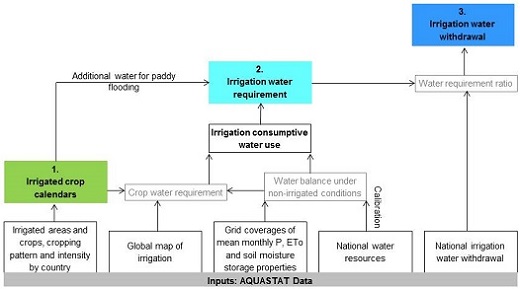AQUASTAT - FAO's Information System on Water and Agriculture

Modelling of global irrigation water use
The AQUASTAT database reports water statistics at country level with a special emphasis on irrigation and agricultural water. Continuous data collection processes populate and update the database, while careful and meticulous data analyses ensure its reliable data quality and accuracy. Despite constant efforts, data gaps exist and AQUASTAT undertakes some limited modelling to fill those for an improved usability, in particular for data relating to agricultural water, its focus. This review contributes to these three tasks: updating, quality checking and gap filling.
Agriculture, and especially irrigated agriculture, is the sector with by far the largest consumptive water use and water withdrawal. To estimate the pressure of irrigation on the available water resources, an assessment has to be made both of irrigation water requirement and of irrigation water withdrawal.
Irrigation water requirement depends on the crop water requirement and the water naturally available to the crops (effective precipitation, soil moisture, etc.). While part can be estimated based on climatic conditions, part results from physiological processes at plant level for which actual figures are not available, calling for modelling (the crop coefficients for the different crops and growing stages are presented in Annex 1. In this review, the model’s inputs are AQUASTAT data related to the corresponding irrigated crops: areas of harvested irrigated crops, cropping patterns and cropping intensity, converted into irrigated crop calendars.
Irrigation water withdrawal (or water withdrawal for irrigation) largely exceeds irrigation water requirement due to significant losses in distribution and application. Although available for some countries, figures of irrigation water withdrawal are easily confused with agricultural water withdrawal. Moreover, in the absence of direct measurement and due to the complexity of assessment methods, they are not always reliable. These difficulties explain that such figures are not always available at country level.
Nonetheless, a review of these variables at country level is necessary to improve the overall quality of global water resources monitoring. The main objective of this review is thus to update the AQUASTAT database with modelled irrigation water requirement, to supplement national data with estimates of irrigation water withdrawal and to check data accuracy and quality thanks to water requirement ratios comparing the two variables. In doing so, the database will provide policy- and decisions-makers as well as the scientific community with a complete dataset containing reliable data, calculated in a uniform way, and comparable with each other at country level.
The first review took place around 2000 within the framework of the preparation of FAO’s global perspective study World agriculture: towards 2015/2030: an FAO perspective for 90 developing countries and countries in transition. The spatial coverage of the data of the present updated review consists of 165 countries1 (out of the total of 198 countries in 2012) and 2 territories, corresponding to those practicing irrigation and for which data on irrigated areas and on irrigated crops are available (see the Discussion for the list of countries not included in this study and Annex 2 for the list of countries included in this review). Among those 167 countries and territories, 41 are high income countries and 1 high income territory, 89 are middle income countries and 1 middle income territory, and 35 are low income countries.
The review consists in a 3-step methodology (summarized in Figure 1 below):
-
Preparation of irrigated crop calendars by country
- Irrigated crop calendars by country
- Regional summary of the irrigated crop calendars
-
Calculation of irrigation water requirement, calculated by the model by comparing:
- The water balance under non-irrigated conditions, corresponding to the actual evapotranspiration under non-irrigated conditions and calculated using available climatic datasets; and
- The crop water requirement based on the irrigated crop calendars and the global map of irrigation areas.
-
Estimation of irrigation water withdrawal for countries with unavailable national statistics using a water requirement ratio
- Estimation of irrigation water withdrawal by country
- Corrections of irrigation water requirement and irrigation water withdrawal
- Pressure on water resources due to irrigation: regional summary of the water requirement ratio
This methodology description is followed by three other sections:
FIGURE 1
: Review of irrigation water requirement and irrigation water withdrawal

1 Although in July 2011 Sudan became two countries, Sudan and South Sudan, in this review the two countries are still grouped together due to the lack of disaggregated data.